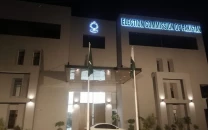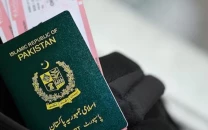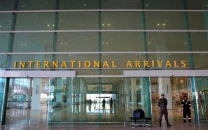Security sources reveal details of Pakistan's massive cyberattack against India
Pakistani cyber team caused severe damage to Indian communications, disabling official govt emails, OTP infrastructure

Security sources has shared details regarding major cyber counter-offensive by Pakistan, under Operation Bunyanum Marsoos, launched in response to Indian aggression, targeting key infrastructure sectors across India.
The cyber wing of Pakistan’s armed forces was “actively involved” in the operation, inflicted significant disruptions across multiple Indian domains, including power infrastructure and petroleum systems, they added.
Sources revealed that the Pakistani cyber team caused severe damage to Indian communications, disabling official government emails and the OTP infrastructure, adding that national communications suffered heavy disruption.
Read More: Pakistan and India agree to immediate ceasefire
Sources stated that India’s surveillance systems were also compromised. Hackers destroyed communication hardware and defaced numerous Indian websites, they said.
Servers at Indian airports were taken down, impacting the Indian Air Force’s communications and interrupting railway systems across several regions, security sources revealed.
پاکستانی سائبر ٹیم نے بھارت کے پاور اور پیٹرولیم سیکٹر ز کو نشانہ بنایا
— PTV News (@PTVNewsOfficial) May 15, 2025
For details please visit https://t.co/8mujtA9Kdy pic.twitter.com/cuFIJLsIY1
Sources further said the Pakistani team gained access to India's national, eastern, northern, and western load dispatch centres, temporarily disabling systems, adding that the breach cut electricity to approximately 80% of Indian consumers for a limited period.
According to internal reports, over 4,600 power feeders in Maharashtra, 3,600 in Uttar Pradesh, and more than 600 in Indian Illegally Occupied Jammu and Kashmir (IIOJK) were hacked and disconnected.
In Indian Punjab, two AI-powered servers at the load dispatch centre were disabled. Meanwhile, in Karnataka, more than 235 solar and wind grid stations were hacked and rendered inoperative, they added.
Read More:Pakistan downs five Indian fighter jets in retaliation for India's missile attack
Sources also confirmed that databases of Hindustan Petroleum Corporation Ltd. (HPCL) and Indraprastha Gas Ltd (IGPL) were targeted, adding that over 4,400 government and public-sector communication routers were also brought down.
They added that a large-scale Distributed Denial of Service (DDoS) attack was launched on major Indian government, military, air force, stock exchange, and public-sector servers, which paralysed internal communications and email/OTP workflows.
“More than 3,500 CCTV cameras installed in government buildings, hospitals, highways, and public zones were also reportedly hacked,” sources said. In IIOJK, over 250 key ISP routers were compromised, resulting in localised internet outages, they added.
The operation accessed and extracted data from over 90 government and corporate sector websites, including those belonging to the Indian Air Force, Hindustan Aeronautics Ltd., Border Security Force, Unique Identification Authority of India, and Indian Railways.
Airport servers in Mumbai, Delhi, and Kolkata were among those hacked, sources shared. The Indian Air Force’s communication systems across its northern, southern, and western commands were also disrupted while Indian Railways experienced operational delays due to compromised servers, they added.
Read More: Pakistan Army announces conclusion of Operation Bunyanum Marsoos
Pakistan Armed Forces conducted Operation Bunyanum Marsoos on May 10 as part of the military conflict 'Marka-e-Haq' in response to Indian military’s dastardly attacks that began on the night of May 6 and 7, resulting in the loss of innocent civilian lives, including women, children, and the elderly.
On May 10, Pakistan launched Operation Bunyanum Marsoos and deployed its Al-Fatah missile and targeted multiple Indian military installations. However, after the intervention of US President Donald Trump, a full and immediate ceasefire was reached between India and Pakistan.
PAF also shot down 5 indian jets in response to unprovoked aggression and airspace violations. According to the military spokesperson, the aircraft shot down included three Rafale jets, one MiG-29, one SU-series aircraft, and an Israeli-made Heron combat drone. The jets were downed in multiple locations, including Bhatinda, Jammu, Akhnoor, Srinagar, and Avantipur.
Read More: PM Shehbaz confident IWT, Kashmir issues with India will be resolved
A full and immediate ceasefire between India and Pakistan was announced on May 10, following days of heightened military exchanges that brought the two nuclear-armed neighbours to the brink of war.
The announcement was first made by US President Donald Trump and later confirmed by Pakistan’s Prime Minister Shehbaz Sharif, Deputy Prime Minister Ishaq Dar, Indian External Affairs Minister S Jaishankar, and US Secretary of State Marco Rubio.
Tensions escalated between India and Pakistan after the Pahalgam attack in IIOJK. India blamed Pakistan without presenting any evidence, while Islamabad rejected the allegations. In response, India suspended the Indus Waters Treaty — a move Pakistan has called an “act of war.”
Following diplomatic intervention led by Washington, both sides agreed to halt military activity across land, air, and sea. However, hours after the truce, fresh skirmishes were reported on both sides of the Line of Control.


















COMMENTS
Comments are moderated and generally will be posted if they are on-topic and not abusive.
For more information, please see our Comments FAQ